Click on images to enlarge

large infestation (Photo: Jackie Miles)

infestation (Photo: Sheldon Navie)

habit (Photo: Sheldon Navie)

habit, with a mixture of short upright flowering stems and longer creeping stems (Photo: Sheldon Navie)

creeping stem with paired leaves that have somewhat heart-shaped bases (Photo: Sheldon Navie)
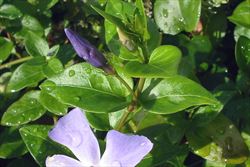
upright stem with flower buds in the forks of the glossy leaves (Photo: Sheldon Navie)
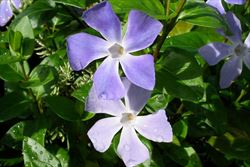
flowers (Photo: Sheldon Navie)
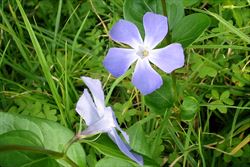
flower from side-on showing the flower tube and long and narrow sepals (Photo: Sheldon Navie)
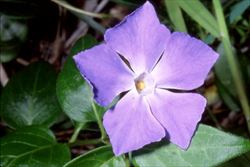
close-up of flower with five spreading petal lobes (Photo: Greg Jordan)
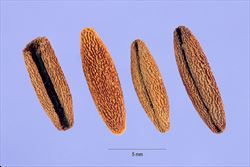
close-up of seeds (Photo: Steve Hurst at USDA PLANTS Database)
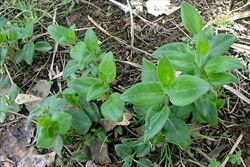
re-growth from creeping underground stems (Photo: Sheldon Navie)

habit of Vinca major 'Variegata' (Photo: Sheldon Navie)
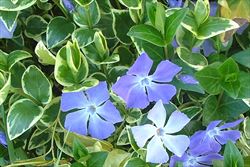
flowers and variegated leaves of Vinca major 'Variegata' (Photo: Sheldon Navie)
Scientific Name
Vinca major L.
Family
Apocynaceae
Common Names
band plant, big leaf periwinkle, big periwinkle, big-leaf periwinkle, bigleaf periwinkle, blue buttons, blue periwinkle, greater periwinkle, large periwinkle, large-leaved periwinkle, periwinkle, sorcerer's violet, vinca
Origin
Thought to be native to southern Europe (i.e. France, Spain, Italy, Albania and Yugoslavia) and possibly also northern Africa, though its exact native range is obscure.
Cultivation
A garden plant (i.e. ornamental) that is widely grown as a groundcover, particularly in temperate regions. A cultivar with variegated leaves (i.e. Vinca major 'Variegata') is also common in cultivation.
Naturalised Distribution
Widely naturalised in southern Australia (i.e. in eastern and southern New South Wales, the ACT, Victoria, Tasmania, south-eastern and eastern South Australia and in south-western Western Australia). Also naturalised on Lord Howe Island and Norfolk Island, and occasionally naturalised in the cooler parts of south-eastern Queensland.
Widely naturalised overseas, including in the Mediterranean region, North America (i.e. Canada and the USA) and New Zealand.
Habitat
This species prefers shaded habitats and is a weed of urban bushland, open woodlands, watercourses (i.e. riparian areas), roadsides, gardens, disturbed sites and waste areas in temperate and occasionally also sub-tropical regions.
Habit
A long-lived (i.e. perennial) herbaceous plant growing up to 0.5 m tall. Its aboveground stems are mostly creeping or trailing and can form mats of vegetation up to 10 m or more across. However, short upright flowering stems are also produced.
Distinguishing Features
- a long-lived herbaceous plant with creeping or trailing stems, as well as short upright flowering stems.
- these stems are hairless and filled with milky sap.
- its paired glossy green leaves (1.5-9 cm long) have some fine hairs along their margins.
- its blue to purple tubular flowers (3-6 cm across) are usually borne singly in the upper leaf forks.
- these flowers have five long and narrow sepals (6-17 mm long) and five spreading petal lobes (13-25 mm long).
- its elongated fruit (3.5-5 cm long and up to 4 mm wide) are often slightly curved and are usually borne in pairs.
Stems and Leaves
The stems sometimes develop roots (i.e. adventitious roots) where they come into contact with the soil (i.e. they are stoloniferous) and creeping underground stems (i.e. rhizomes) are also produced. These green slender stems are hairless (i.e. glabrous) and have a milky sap (i.e. white latex).
The oppositely arranged leaves are borne on stalks (i.e. petioles) 5-20 mm long. These leaves (1.5-9 cm long and 1.5-6 cm wide) are egg-shaped in outline (i.e. ovate) or almost round (i.e. orbicular) in shape with rounded or slightly heart-shaped (i.e. sub-cordate) bases. Their upper surfaces are glossy green in nature, while their undersides are paler and duller in appearance. They have entire margins and pointed or rounded tips (i.e. acute to obtuse apices). Both leaf surfaces are mostly hairless (i.e. glabrous), however there are some fine hairs along the leaf margins (i.e. they are ciliate).
Flowers and Fruit
The tubular flowers (3-6 cm across) are usually borne singly, in the upper leaf forks, on stalks (i.e. peduncles) 2-6 cm long. These flowers have five long and narrow sepals (6-17 mm long), which are hairy (i.e. pubescent), and have pointed tips (i.e. acuminate or subulate apices). The petals are fused together at the base into a tube (i.e. corolla tube) 13-18 mm long and have five spreading blue, mauve, violet or purple petal lobes (13-25 mm long). Each flower also has five stamens, which are attached to the inside of the corolla tube, and an ovary topped with a style and stigma. Flowering occurs throughout the year, but mainly during spring and summer.
The elongated fruit (i.e. follicles) are often slightly curved and are usually borne in pairs. These fruit (3.5-5 cm long and up to 4 mm wide) are round in cross-section and taper to a pointed tip (i.e. they are cylindrical or fusiform). They turn from green to brown as they mature, contain 1-10 seeds, and may be produced throughout the year. The flattened, hairless seeds (7-8 mm long) are oval (i.e. elliptic) in shape and grooved on one side.
Reproduction and Dispersal
This species sometimes reproduces by seed, but more often it spreads vegetatively via its creeping underground and aboveground stems (i.e. rhizomes and stolons).
These stems enable plants to spread laterally and cover large areas. Longer distance dispersal can occur when stem segments and seeds are spread by water, in contaminated soil, or in dumped garden waste.
Environmental Impact
Blue periwinkle (Vinca major) is regarded significant environmental weed in Victoria, South Australia, Western Australia, New South Wales, the ACT and Tasmania. During a recent survey, it was also listed as a priority environmental weed in six Natural Resource Management regions.
Legislation
This species is declared under legislation in the following states and territories:
- ACT: C4 - a prohibited pest plant (a pest plant whose propagation and supply is prohibited).
- Western Australia: Unassessed - this species is declared in other states or territories and is prohibited until assessed via a weed risk assessment (throughout the entire state).
Management
For information on the management of this species see the following resources:
- the Shire of Yarra Ranges Environmental Weed Fact Sheet on this species, which is available online at http://www.yarraranges.vic.gov.au.
- the Blue Periwinkle page on the South Coast Weeds website at http://www.esc.nsw.gov.au/Weeds/index.asp.
- the Blue Periwinkle page on the Weeds of Blue Mountains Bushland website at http://www.weedsbluemountains.org.au/index.asp.
- the Blue Periwinkle page on the Sustainable Gardening Australia website at http://www.sgaonline.org.au/index.html.
Similar Species
Blue periwinkle (Vinca major) may be confused with lesser periwinkle (Vinca minor). However, these two species can be differentiated from each other by the following differences:
- blue periwinkle (Vinca major) has relatively large flowers (3-6 cm across) with long and narrow sepals (6-17 mm long).
- lesser periwinkle (Vinca minor) has. relatively small flowers (about 2.5 cm across) with short sepals (3-4 mm long). Most naturalised plants in Australia also have white flowers.

